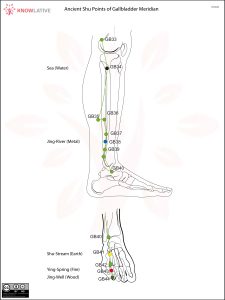The 5 transporting points (Shu points) are sometimes called Command points or Ancient or Antique points.
In the 5 Elements Theory, one of the supporting columns of Traditional Chinese Medicine, every Element is in direct relation with the other 4. To reflect this close relation, every main meridian has a set of points, called Ancient Shu points, that allow the energy flowing in that meridian to communicate with the other 5 meridians of the same polarity (Yin and Yang).
These 5 points, in every main meridian, are located in the distal part of the limb (arm or leg depending on the meridian you are considering) in the area between the fingers and the elbow and between the toes and knee.
The ancient-Shu points have a name depending on the position they have in the leg or in the forearm. From finger/toes to elbows/knees the energy of the meridians change polarity and the ancient Chinese compared this section of the principal meridians to a river. Thus, from fingers/toes to elbows/knees there is a progression in size and depth of the meridian that is irrespective of the direction of the actual direction of flow of the meridian. We have:
- Jing (Well): the first point in the fingers or toes (exception: Kidney meridian is on the sole of the foot). It is like a well where the energy of the meridian is where the energy flow starts: more superficial, the Qi has an outward, centrifugal movement.
- Ying (Spring): the second point of every principal meridian: here Qi flow is swift and there is a lot of potential energy.
- Shu (Stream): this is the third point of the meridian (except in Gallbladder meridian where it is the fourth). In this point, Qi of the meridian pours through, quickens and the defensive Qi gathers.
- Jing (River): it is not always the fourth point along the channel. Flows here is wider and deeper and pathogenic factors are diverted to joints.
- He (Sea): this point is at elbow/knee. In this point Qi is vast, slow. Movement is inward and centripetal.
Every Transporting point is connected to an element depending on the element of the meridian where it belongs. So, in every main meridian the 5 Transporting points are associated to an element following this rule:
- Jing-Well points of Yin meridians are associated to Wood element
- Jing-Well points of Yang meridians are associated to Metal Element
- Going from finger/toe to elbow/knee they follow the Shen cycle of the 5 Elements Theory.
The overall function of these points is:
- Grandmother point: it is the Transporting point related to the grandmother element of the meridian and it is a Control point;
- Mother point: it is related to the mother element of the meridian and it is a Tonification point;
- Ben point: it is the Transporting point related to the same element of the meridian;
- Daughter point: is the point associated to the daughter element of the meridian and generally is a Sedation Point;
- Granddaughter point: it is associated with the granddaughter element and it is a Support point.
These points are used to balance muscles in the Tonification and sedation points – Ancient Shu Points – Meridian Correction.
See the pictures in the meridian description to know the Ancient Shu points of that specific meridian.

